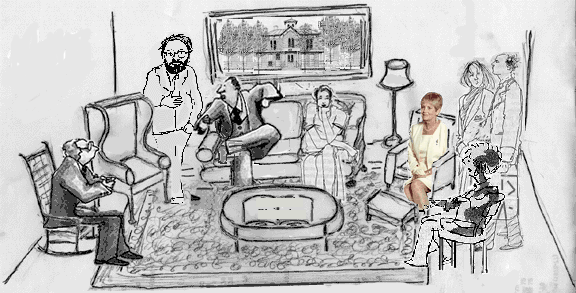I’m going to save some of my discussion for entering a blogosphere for my actual creation submission post, but I wanted to share a few general tools and tricks about organizing content online here. This is in no way an authoritative list; rather, it’s just a few ideas that I’ve used to enter blogospheres in the past.
As we’ve said before in class, the act of entering a blogosphere is somewhat like showing up to a party late. When you first get there, you discover that there’s a lot of people already engaged in conversations, some very related to each other and some only partially relevant. After you move about the room for awhile, you begin to realize where the best conversations are, where the talk that interests you the most is happening, and where the discussions you’d like to avoid are taking place.
I did not come up with this metaphor; it’s a famous bit of rhetorical theory from Kenneth Burke. It helps me think about the challenge of discovering and organizing conversations online. As you develop your blogosphere, it may be helpful to keep the following things in mind.
1. Use some system of organization to make sure that blog content comes to you. Tools such as Twitter, Facebook, WordPress, Tumblr, or RSS readers are essential to the process of organizing information, but they also accomplish an important task of pushing new content when it is published to a central place that you already pay attention to. This group of posts by Lifehacker is a good guide to RSS feed readers. I prefer to use platforms that allow me to subdivide content into folders.
This shot of Feedly shows how I organize several different blogopsheres based on topics that interest me.
2. Build your sphere to include multiple kinds of resources, and from multiple perspectives. This recalls our discussion from last week in class. Do we go out of our way to include multiple perspectives and kinds of information into our blogopsheres? How do we establish boundaries around a sphere?
3. Be open to widening your sphere to include more than just blogs. For instance, consider adding podcasts, magazine columnists, Twitter feeds, organization websites, YouTube channels or any other media entities, broadly defined, that contribute to the sphere of your conversation
4. Mine high quality blogs for their lists of resources. This is the Digital Age equivalent of mining a book for its footnotes and bibliography. When you find a blogger in your sphere who does good work, check out other blogs that are on their reading list:
For instance, this screenshot from a librarian blogger I follow is a good starting point for finding other members of that blogosphere. It’s not cheating, it’s cooperative discovery!
5. Figure out who the major players in the conversation are, but define “major players” however you want. Your sphere should have some limits by default, but you should decide what criteria you’re looking for when making choices about who “belongs” in the conversation and who does not.





I made a Feedly account earlier today and I’ve been looking at blogs like all day! This makes things SO much easier! I was emailing links to myself before, which is probably the least efficient thing I could have done.
So glad you have entered the world of feedly! It makes it easier to check one place and stay informed. Maybe next week in class we can talk about using Feedly and other tools to be efficient participants in a conversation